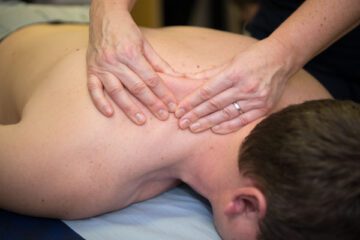Myofascial Release Treatment in Jaipur
Myofascial Release (MFR) is a hands-on therapy used to address musculoskeletal pain and dysfunction. Dr. Arvind Jaga provides Myofascial Release Treatment in Jaipur, catering to patients with chronic pain, muscle tension, headaches, and other musculoskeletal conditions.
During an MFR session, Dr. Jaga employs various techniques to identify areas of tension and restriction in the fascia surrounding muscles and organs. He then applies gentle, sustained pressure using his hands, fingers, or specialized tools to stretch and release the fascia. This process allows the fascia to gradually release and relax.
MFR can benefit individuals with chronic pain, headaches, fibromyalgia, sports injuries, and postural imbalances. The treatment enhances circulation, reduces pain and inflammation, improves mobility, and induces relaxation and stress relief.
If you experience musculoskeletal pain or tension, consider Myofascial Release Treatment with Dr. Arvind Jaga in Jaipur. Contact his clinic to schedule an appointment and discover the advantages of this effective technique in improving your well-being.
What is MFR Treatment ?
Myofascial Release Treatment (MFR) is a form of hands-on therapy that specifically focuses on the fascia, a layer of connective tissue enveloping and providing support to the muscles and organs in the body. The technique involves applying sustained pressure to the fascia to release tension and improve mobility.
During an MFR session, the therapist will use their hands, fingers, or specialized tools to locate areas of tension or restriction in the fascia. They will then apply gentle sustained pressure to these areas, allowing the fascia to stretch and release. The pressure is maintained for several minutes to allow the fascia to gradually relax.
Myofascial Release Treatment (MFR) is versatile and effective, providing relief for various conditions such as chronic pain, headaches, sports injuries, and postural imbalances. The treatment can help to improve circulation, reduce pain and inflammation, enhance mobility, and promote relaxation and stress relief.
MFR is often used in conjunction with other forms of therapy, such as massage and exercise, to provide a comprehensive approach to pain relief and recovery. It is a safe and effective technique that can be tailored to the individual needs of each patient.
How Does Myofascial Release Treatment Work?
Myofascial Release Treatment (MFR) works by applying gentle sustained pressure to the fascia, which is a layer of connective tissue that surrounds and supports the muscles and organs. The fascia can become tight and restricted due to physical and emotional stress, leading to pain, limited mobility, and other symptoms.
During an MFR session, the therapist identifies areas of tension and restriction in the fascia and applies pressure to these areas using hands-on techniques. This pressure is maintained for several minutes to allow the fascia to gradually stretch and release, which can improve circulation, reduce pain and inflammation, and enhance mobility.
MFR also helps to break down adhesions and scar tissue that can form in the fascia due to injury or surgery, which can limit mobility and cause pain. By releasing these adhesions and scar tissue, MFR can help restore function and reduce pain and discomfort.
MFR can be used alone or in conjunction with other forms of therapy, such as massage and exercise, to provide a comprehensive approach to pain relief and recovery. It is a safe, non-invasive treatment that can be tailored to the individual needs of each patient.
Benefits Of Myofascial Release Treatment
Myofascial release is a type of therapy that involves the application of gentle sustained pressure to the connective tissue (fascia) in the body. This therapy is used to help relieve pain and improve mobility in people with a variety of conditions, including chronic pain, fibromyalgia, and sports injuries. Some of the benefits of myofascial release treatment include:
Pain relief: Myofascial release therapy can help reduce pain by releasing tension in the muscles and fascia that may be causing discomfort.
Increased range of motion: By releasing tension and adhesions in the fascia, myofascial release therapy can help improve mobility and range of motion in the affected area.
Improved circulation: Myofascial release therapy can also help improve circulation, which can reduce inflammation and promote healing.
Improved posture: By releasing tension in the fascia, myofascial release therapy can help improve posture and alignment, which can help reduce pain and discomfort.
Reduced muscle tension: Myofascial release therapy can help reduce muscle tension and tightness, which can help improve overall relaxation and reduce stress.
Enhanced athletic performance: Myofascial release therapy enhances athletic performance by alleviating muscle tension, increasing range of motion, and minimizing injury risk
Relief from headaches: Myofascial release therapy can help relieve tension headaches by releasing tension in the neck and shoulder muscles.
Overall, myofascial release therapy can be a highly effective form of treatment for a variety of conditions, helping to reduce pain, improve mobility, and promote overall health and wellness.